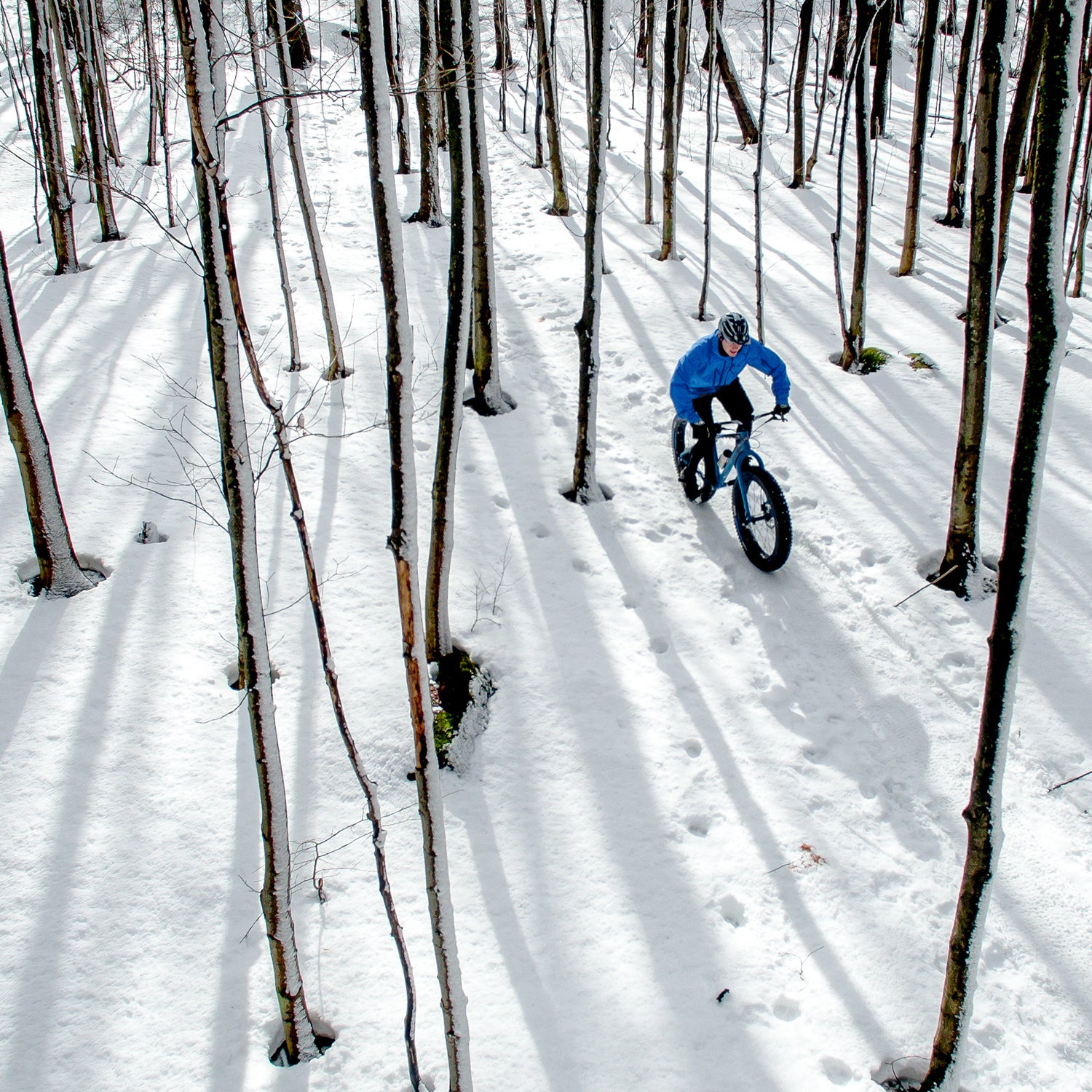If you’ve ridden bikes in winter, you know that snow conditions often exceed the capabilities of bikes—even fat ones. You can ride with six or eight inches or maybe even a bit more fresh, but unless the powder falls on top of consolidated snow, bikes quickly become ballast. The sort of powder skiers dream of fluffing through is the equivalent of quicksand for two-wheeled rigs.
In Marquette, Michigan, a group of riders had the same realization about the limitations of fat bikes and decided to do something about it. They began building winter trails expressly for mountain bikes. Already a hotbed for summer riding on the banks of Lake Superior, the town has extended its bike season year-round with a network of groomed fat-bike trails that stretch over 80 miles. Plans are afoot for more.
“It’s exploding,” says Candy Fletcher, recreation director for the city of Marquette. “We’re seeing fat-bikers travel here the way snowmobilers and skiers do. A group ride on the drew 40 to 50 people every Wednesday last winter.”
The winter-trail development officially started eight years ago, but fat biking’s start here stretches back decades. , released four years ago, details snow riding’s evolution in Marquette, from locals fooling around on snowbanks in the 1970s to BMXers packing out jump courses for winter stunts in the ’80s to a hilarious-looking race series aboard standard mountain bikes on ski runs at nearby resorts. There’s even an archival television news story from the time about the trend.
As fat bikes advanced and proliferated, dedicated snow trails were inevitable. A grassroots grooming effort in 2010 culminated in the Snow Bike Route, a 15-mile winter singletrack at one of the town’s summer riding areas, the . “Did Marquette invent the snow bike singletrack? I’m not sure. We don’t know what other people were out there doing in the backwoods,” says Mike Brunet, a board member at Noquemenon and one of the people responsible for that first winter trail. The question alone speaks to Marquette’s influence.
Perhaps the town’s biggest contribution has been the development of grooming machinery and techniques specific to bike trails. Whereas nordic ski resorts lay wide tracks using snowcats and snowmobiles, developers in Marquette wanted sinuous thread-like trails, no bigger than a foot or two across, that looked and rode like singletrack in the summer. Some 200 inches of snow fall annually in Marquette, with big years stretching to 350 inches, and the challenges of the wet Midwest snowpack, coupled with the heavily treed terrain, made for interesting trail-building challenges. Machinery includes a traditional cross-country ski drag sawed and welded to two feet wide, a four-wheeler plow cut in half and souped up with lawn-tractor tires and a trailer jack, and an ATV tiller hacked down and tines trimmed. On some trails, they even use a two-wheel-drive military motorcycle called a Rokon Trailbreaker pulling a 15-inch car tire.
“I’ve been doing fat-bike summits since 2012, from Vermont all the way out to the West, and Marquette is leading the way in terms of equipment and how they deal with snow and trails,” says Gary Sjoquist, advocacy director for Minneapolis-based distributor Quality Bicycle Parts. “They are moving the whole industry forward.”
It’s not just recreation, either—it’s also economics. In Michigan, tourism from snowmobiling has fallen by 10 percent in the past decade, and hunting and fishing is down by a third. “Our town used to count on those dollars,” says Fletcher. “But with all of that decreasing, our winter occupancy in Marquette is on the rise. I attribute that growth to fat biking.” According to one recent , 64 percent of fat-bike owners are willing to pay to ride groomed trails. That could be of interest to cross-country ski resorts, which have seen over declines thanks to falling interest and tough weather. “Some of the more progressive cross-country areas are realizing that fat biking could help their businesses,” says Sjoquist.
The idea that infrastructure and interest in biking is a legitimate revenue stream is still in its infancy, but it’s beginning to spread. There are now dedicated winter trails at Grand Targhee and Park City ski resorts and in state parks like Wyoming’s Kurt Gaudi and a few Forest Service units in Utah. Events like the self-proclaimed in Crested Butte, Colorado, which is also developing dedicated trails for snow bikes, and the in Anchorage, where the fat-bike traffic keeps in-town singletrack open all winter long, are also proving that fat bikes can drive traffic—and dollars.
But really it’s about getting out and shredding in the snow, sending rooster tails of powder skyward, and executing the occasional hilarious ice-cold face plant. In a forthcoming follow-up to Cold Rolled, called Whack Jobs, one local put it like this: “The more time you spend out here, the less time you spend on Prozac.”


